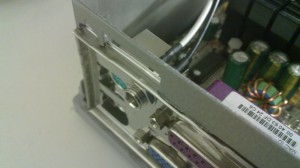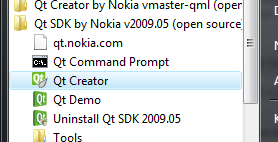In these turbulent times, I just wanted to share some bright news.
We’re hiring developers who want to work on MeeGo and Qt on the bleeding edge in a challenging industry. Check out our application page at http://pelagicore.com/careers/.
In these turbulent times, I just wanted to share some bright news.
We’re hiring developers who want to work on MeeGo and Qt on the bleeding edge in a challenging industry. Check out our application page at http://pelagicore.com/careers/.
Recently, Skype seems to hang in some odd offline mode without indicating this. I run a fairly vanilla Kubuntu install so this ought affect more people out there. The remedy for this is a set of scripts available from the Skype Reliabilitator page. Now, you can simply run check-skype-status and Skype restarts if needed.
As all great projects, this one started with a Dremel and some destruction. The back side of my external SCSI hdd boxes from sun was to receive a make over. One thing can be said about the boxes – they are heavy and now I know why. There was quite a lot of steel to cut through, but the results where nice.
To fit the board in the box, I superglued a set of distances to the chassis. There is about 2-3mm of margin to fit the board in, so it was tight.
Then I fitted a 80W PicoPSU. This allowed me to move the main part of the power supply outside the box, as the PicoPSU is powered by a 12V DC power brick.

To get the power through, I had to make an extra hole in the plates for the motherboard’s connectors. That is how tight the fit was. No additional space on the back side to drill an additional hole.
The system is run from an 8GB CompactFlash card. Most cards can apparently be used as an PATA/IDE drive. As the CF-to-IDE converter had a floppy drive power connector, I had to build a cable for it. Also, notice the tape in the top right corner of the converter – it covers a really bright red LED.
And here is the real LED. It is green and it is original. Connected nicely with the HDD activity pins of the motherboard.
So, here it is again. A sun box has sparked into new life.
It has been quite a while since I last blogged. As always, there is not a single reason for this, but the major one is that have been swamped with work. This text will be a small re-cap and a way for me to start with a fresh-ish slate this year.
First of all, the Qt in Education material is finally completed. I was at the München Qt DevDays and presented what we had then. Since then the slides and exercises have been completed and received a polish. There is already a small errata in the Qt DevNet wiki. I choose to interpret this as a Good Thing – people are using the material.
Just after the new year, a team from Pelagicore attended CES. I did not go there this year (small kids change your priorities) but worked hard on a set of Qt-based demos that we ran there. The demos (and Pelagicore as a company) are focused on in-vehicle infotainment, or IVI as it is commonly written. Of course there are a million things that I as an engineer want to polish or add, but as a whole the event was a success.
So, there it is, a new starts. Now I will try to blog more frequently.
The Nordic Free Software Award given to people, projects or organisations in the Nordic countries that have made a prominent contribution to the advancement of Free Software. The award will be announced during FSCONS 2010 in Gothenburg.
If you want to nominate someone or something, you can find more information here.
Could anyone enlighten me as to where one files bugs in the Smart Installer for Symbian? Apparently it does not play well without a SIM-card…
 When installing the Qt SDK for Windows you get a set of pre-compiled Qt libraries as well as Qt Creator.
When installing the Qt SDK for Windows you get a set of pre-compiled Qt libraries as well as Qt Creator.
When using this Qt version for building an installer, it is important to pick the correct Qt dlls to ship with your application.
The SDK comes with two sets of dlls. One set resides in $BASEDIR/bin and the other in $BASEDIR/qt/bin. The former contains the dlls used by Qt Creator, while the latter are the dlls that you want to ship with your executable.
Thanks to Marcus for this tip!
First post with WordPress 3.0 – fingers crossed but so far it looks good!
I’ve learned a small detail today – QFtp requires login even if you do not have any username or password to give the server. Saves some time from debugging time knowing that calling login once fixes this. (Yes, me stupid)
For those of you learning Qt or wanting to get started with Qt, I will hold a session on the Kubuntu Tutorial Day. I hope to see you there!
Also, great rainy weekend. Got loads of stuff done ranging from catching up on some work to restructuring parts of the garage.
It has been a long time since I blogged last. Life has been chaotic, and as June closes to an end, it is getting worse. However, I’ve promised myself to clear all current projects during June (apart from some continuously ongoing stuff) to have a fresh start after my summer vacation.
Loads of exciting things are happening this fall. Some highlights are: